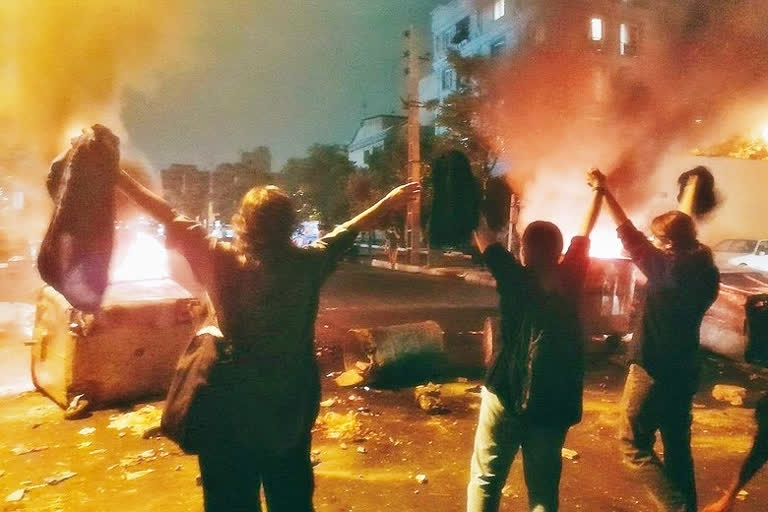The protests that erupted in Iran after Mahasa Amini, a 22-year-old Kurdish woman, was killed while she was held by "morality police" for allegedly not properly wearing the headscarf, seem to be showing no signs of abating; rather, they have spread to 80 other Iranian cities.
The city of Saqquez in the Kurdistan province, where the majority of Kurds live and practise Sunni Islam, is where Amini was buried. When mourners gathered on the 40th day after Amini's death to pay their customary Iranian homage and express solidarity for the bereaved family, a violent incident occurred that left several of the attendees dead and many others injured. Apparently it was the handiwork of the terror group ISIS because Kurds have been fighting against them in Syria at the behest of the West, primarily the US. The fact that ISIS accepted responsibility made no difference, and the protests not only continued, but intensified across the city. The protesting youth in Saqquez tore their headscarves off and set them afire in full public glare. It became the first Iranian city to openly defy the rules of the country. After the protests grew violent, they went out of control, and the central government of Iran had to launch a massive crackdown to contain the uprising.
The deaths made more protests inevitable. As per Iranian custom, people congregate on the 40th day after the demise of their dear ones to grieve and express solidarity for the bereaved. People believe that Amini was killed because she was a Kurd, as they have been an eyesore for Iran ever since the Iranian revolution, with the roots of the conflict largely in the Kurdish region of western Iran.
Apart from Kurdistan, which has a history of separatism, cities like Ifshahan and Zahedan have been clandestinely expressing their dissatisfaction with the rules that are imposed on women throughout the country. Ifshahan is a city of art and crafts and home to around 20,000 Persian Jews. The women in Ishfahan took to the streets too, in solidarity with women of other parts of Iran, and sought the prosecution of those responsible for Amini's murder and the killing of hundreds.
Ifshahan has largely been a calm city and has mostly been engaged in trade and tourism. The city, with 13 synagogues, has hardly been part of any unrest or controversy, which is probably the reason why the former supreme leader, Ayotallah Khomani, allowed the Jews to stay after the Iranian revolution of 1979.
The turmoil in Isfahan has a greater significance in light of the comments made recently by Iran's supreme leader, Ayatollah Ali Khamenei, who indicted the West and Zionists for the unrest and ongoing protests in Iran. However, he made no mention of Persian Jews, nor did he make any explicit mention of areas that are dominated by Sunnis or other minorities in the country.
In the same breath, he targeted America for the uprising. Since the Kurds receive military assistance from the United States, Iran obviously needs to be concerned. Despite the fact that protests have erupted in many cities, governments are focused on Ishfahan, Zahedan, and Saqqez. The number of casualties has also been higher in these cities, which has given analysts enough material to pour out their hearts. To top it all, international human rights organisations have reported discrimination in places such as Zahedan, where Iran has been accused of committing atrocities such as massacres to quell protests.
Zahedan is one of the few Iranian cities with a majority of Sunni Muslims. They accused the Iranian government of employing force to silence the voices of Sunni women. The city is capital of Sistan and Baluchestan province and has had the highest death toll since protests broke out. On Fridays, large deployments are made in front of the mosques to put an end to any potential protests.
Media reports suggest, there have been over 300 civilian deaths and close to 14,000 people have been either detained or jailed across the nation. The severity of the disturbance this time after Amini's death, in September, has caused the central government a great concern. Multiple strategies deployed to divert the protesting youth from their cause did not fructify. One of them was to revive the notion of seeking revenge for the death of Qasim Sulaimani, one of the demands made by the public when he was killed by a US drone in Iraq in 2020.
All of the tactics used by the government failed and made no breakthrough for them. It appears to have even crossed over into Iranian system. This week, the Iranian water polo athletes competing in the Asian Championship in Bangkok declined to sing the national anthem. Vafa Hakhamaneshi, a football player for Chennaiyin Football Club, demonstrated support for protesting women after scoring against Bengal.
The Iranian administration is battling skepticism, which has led to a great divide between liberals and Islamic conservatives. Iranian liberals are now hand in glove with bewildered minorities in cities like Zahedan, Ishfahan, Saqquez, etc., making it challenging for the government to maintain law and order. As a result, Iran's so called believers are now a minority in their own nation.



